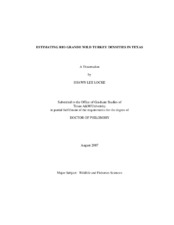| dc.description.abstract | Rio Grande wild turkeys (Meleagris gallopavo intermedia) are a highly mobile, wide ranging, and secretive species located throughout the arid regions of Texas. As a result of declines in turkey abundance within the Edwards Plateau and other areas, Texas Parks and Wildlife Department initiated a study to evaluate methods for estimating Rio Grande wild turkey abundance. Unbiased methods for determining wild turkey abundance have long been desired, and although several different methods have been examined few have been successful. The study objectives were to: (1) review current and past methods for estimating turkey abundance, (2) evaluate the use of portable thermal imagers to estimate roosting wild turkeys in three ecoregions, and (3) determine the effectiveness of distance sampling from the air and ground to estimate wild turkey densities in the Edwards Plateau Ecoregion of Texas. Based on the literature review and the decision matrix, I determined two methods for field evaluation (i.e., infrared camera for detecting roosting turkeys and distance sample from the air and ground). I conducted eight ground and aerial forward-looking infrared (FLIR) surveys (4 Edwards Plateau, 3 Rolling Plains, and 1 Gulf Prairies and Marshes) of roost sites during the study. In the three regions evaluated, I was unable to aerially detect roosting turkeys using the portable infrared camera due to altitudinal restrictions required for safe helicopter flight and lack of thermal contrast. A total of 560 km of aerial transects and 10 (800 km) road based transects also were conducted in the Edwards Plateau but neither method yielded a sufficient sample size to generate an unbiased estimate of the turkey abundance. Aerial and ground distance sampling and aerial FLIR surveys were limited by terrain and dense vegetation and a lack of thermal contrast, respectively. Study results suggest aerial FLIR and ground applications to estimate Rio Grande wild turkeys are of limited value in Texas. In my opinion, a method for estimating Rio Grande wild turkey densities on a regional scale does not currently exist. Therefore, the Texas Parks and Wildlife Department should reconsider estimating trends or using indices to monitor turkey numbers on a regional scale. | en |


